

Organs For Human Transplant Are Being Grown Inside Sheep And Pigs. We don’t have enough organs for transplant, but it’s not as though governments and scientists are sitting back idly.
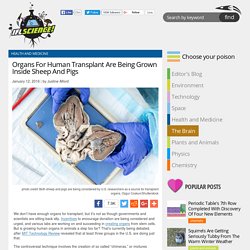
Incentives to encourage donation are being considered and urged, and various labs are working on and succeeding in creating organs from stem cells. But is growing human organs in animals a step too far? That’s currently being debated, after MIT Technology Review revealed that at least three groups in the U.S. are doing just that. The controversial technique involves the creation of so called “chimeras,” or mixtures between humans and farm animals. Although the work has yet to be published, the information gathered by MIT from the scientists themselves indicates that roughly 20 successful pregnancies were established in either pigs or sheep last year, but all were terminated before reaching full-term.
And at work presented last November at the National Institutes of Health facility in Maryland, scientists revealed just how far their research has progressed. Cancer Patient Receives 3D-Printed Titanium Ribcage. A cancer patient in Spain has received a 3D-printed chest prosthetic made of lightweight titanium in a first-of-its-kind surgery.
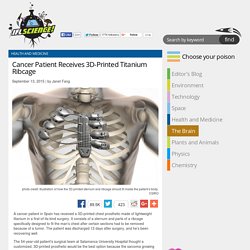
It consists of a sternum and parts of a ribcage specifically designed to fit the man’s chest after certain sections had to be removed because of a tumor. The patient was discharged 12 days after surgery, and he’s been recovering well. The 54-year-old patient’s surgical team at Salamanca University Hospital thought a customized, 3D-printed prosthetic would be the best option because the sarcoma growing around his ribcage meant they’d have to replace a significant portion of his chest – a part that’s notoriously tricky to recreate. Its complex geometry meant a prosthetic would have to be tailored specifically for the patient. Flat plates and screws made of titanium have previously been implanted by thoracic surgeons, but these can loosen over time, causing complications and possibly reoperations.
Image in the text: Anatomics. Baby's life saved with groundbreaking 3-D printed device that restored his breathing. Every day, their baby stopped breathing, his collapsed bronchus blocking the crucial flow of air to his lungs.

April and Bryan Gionfriddo watched helplessly, just praying that somehow the dire predictions weren't true. "Quite a few doctors said he had a good chance of not leaving the hospital alive," says April Gionfriddo, about her now 20-month-old son, Kaiba. "At that point, we were desperate. Anything that would work, we would take it and run with it. " They found hope at the University of Michigan, where a new, bioresorbable device that could help Kaiba was under development. Green and his colleague, Scott Hollister, Ph.D., professor of biomedical engineering and mechanical engineering and associate professor of surgery at U-M, went right into action, obtaining emergency clearance from the Food and Drug Administration to create and implant a tracheal splint for Kaiba made from a biopolymer called polycaprolactone. "It was amazing. "The material we used is a nice choice for this.
3D-printed hip implant lets teenager walk again. The 3D-printed implant that has given a once wheelchair-consigned teenager the ability to walk on her own Image Gallery (2 images) Much of the fanfare surrounding 3D printing has centered on its enabling consumers to create objects themselves, potentially circumventing traditional production models.
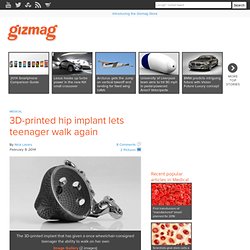
Alongside NBA figurines and 3D printed pizza, however, the technology continues to provide valuable solutions in the field of medicine. A Woman Has Been Given A New 3D Printed Skull. A team from the University Medical Centre, Utrecht, have made medical history by successfully replacing a woman's entire skull with a plastic one made by a 3D printer.
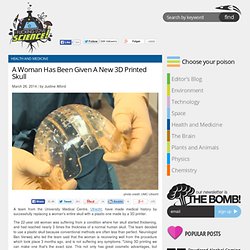
The 22-year old woman was suffering from a condition where her skull started thickening, and had reached nearly 3 times the thickness of a normal human skull. The team decided to use a plastic skull because conventional methods are often less than perfect. Neurologist Ben Verweij who led the team said that the woman is recovering well from the procedure which took place 3 months ago, and is not suffering any symptoms.
Paralyzed woman walks again with 3D-printed robotic exoskeleton. A 3D printed robotic exoskeleton has enabled a woman paralyzed from the waist down to walk again Image Gallery (5 images) 3D Systems, in collaboration with Ekso Bionics, has created a 3D-printed robotic exoskeleton that has restored the ability to walk in a woman paralyzed from the waist down.

The Ekso-Suit was trialled and demonstrated by Amanda Boxtel, who was told by her doctor that she'd never walk again after a skiing accident in 1992. View all Robotic exoskeletons were once the stuff of sci-fi movies, bestowing their wearers with superhuman strength and speed. 3D printing cancer drugs molecule-by-molecule, using DNA scaffolds. Imagine designing parts that can self-assemble into a house. Now imagine that these same houses can self assemble into cities. On the nanoscale, as for biomolecules and tissues, this scenario is so commonplace that it hardly deserves mention: Your entire body, and every other living thing on Earth, self-assembled. If the designer is not the whole of nature itself, however, but a human with a fancy CAD program calling the shots, you might sit up and take notice.
3D Printing Profits from the Health Care Industry. I managed to go 12 full years before breaking my first bone.

It happened during the fall of 1983 while playing football with some neighborhood kids. 10 ways 3D printing is changing the medical world. 3D printing has changed the world in quite a few aspects, but I think we all should pay more attention to its advances within the medical world.

Some of the things that this technology can do will blow your mind, and it could potentially save your life, too. Custom Jaw Implants Patient-specific cases require entirely unique parts and apparatuses to be manufactured, and 3D printing is pretty reliable when it comes down to creating accurate pieces. One case in particular sticks out in my mind. Scientists 3D Print Human-Scale, Living Tissues. Need some new muscle?
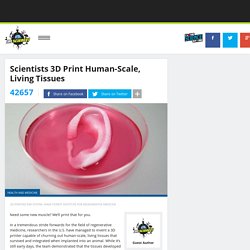
We’ll print that for you. In a tremendous stride forwards for the field of regenerative medicine, researchers in the U.S. have managed to invent a 3D printer capable of churning out human-scale, living tissues that survived and integrated when implanted into an animal. While it’s still early days, the team demonstrated that the tissues developed the right strength and function required for human application, raising the possibility that the technique could one day be used to help people whose tissue has been damaged by disease or trauma. The research is published in the journal Nature Biotechnology. “We know from other industries that 3D printers can print objects of any size and shape,” senior author Anthony Atala from the Wake Forest Institute for Regenerative Medicine told IFLScience.
On top of that, problems with structural integrity mean that the printed tissues are often too flimsy to survive after being implanted. The 3D printer hard at work.